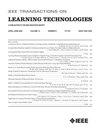增强静脉针插入训练与双手触觉VR模拟器:发展,可用性和学习的影响
IF 4.9
3区 教育学
Q2 COMPUTER SCIENCE, INTERDISCIPLINARY APPLICATIONS
引用次数: 0
摘要
培训医疗保健专业人员静脉注射(IV)针插入是医学教育的一个重要组成部分,传统上依赖于基于人体模型的模拟和现实生活中的实践。然而,触觉虚拟现实(HVR)技术的出现为这种培训提供了一种变革性的方法,提高了安全性和潜在的效率。本研究探讨了在Unity平台上使用两种不同的触觉设备集成到VR系统中的静脉针头插入模拟器的开发,并通过为期三周的实验评估其对学习的影响。该模拟器旨在通过结合详细的解剖模型,基于物理的手交互和实时触觉反馈来创建逼真的沉浸式训练环境。虚拟环境复制了临床环境,具有患者手臂模型和静脉注射针。触觉反馈被编程为提供针插入和手抓握的真实感觉,提高用户的准确性。41名学生的学习影响和可用性测试表明,在技能习得和信心方面有很大的改善。具体来说,参与者的成功率提高了55%,信心也显著增强。这种高保真HVR模拟器代表了医疗培训技术的重要一步,提供了可扩展和可重复的培训工具,可适应各种教育需求和技能水平。本文章由计算机程序翻译,如有差异,请以英文原文为准。
Enhancing IV Needle Insertion Training With a Bimanual Haptic VR Simulator: Development, Usability, and Learning Impact
Training healthcare professionals in intravenous (IV) needle insertion is a critical component of medical education, traditionally relying on manikin-based simulations and real-life practice. However, the advent of haptic virtual reality (HVR) technologies offers a transformative approach to this training, enhancing safety and potential efficiency. This study explores the development of an IV needle insertion simulator using two different haptic devices integrated into a VR system on the Unity platform and assesses its impact on learning through a three-week experiment. The simulator is designed to create a realistic and immersive training environment by incorporating detailed anatomical models, physics-based hand interactions, and real-time haptic feedback. The virtual environment replicates a clinical setting, featuring a patient arm model and an IV needle. The haptic feedback is programmed to offer realistic feelings of needle insertion and hand grasping, improving the user’s accuracy. Learning impact and usability testing with 41 students indicate a promising improvement in skill acquisition and confidence. Specifically, participants showed a 55% increase in success rates and a significant boost in confidence. This high-fidelity HVR simulator represents a significant step forward in medical training technologies, offering a scalable and repeatable training tool adaptable to various educational needs and skill levels.
求助全文
通过发布文献求助,成功后即可免费获取论文全文。
去求助
来源期刊

IEEE Transactions on Learning Technologies
COMPUTER SCIENCE, INTERDISCIPLINARY APPLICATIONS-
CiteScore
7.50
自引率
5.40%
发文量
82
审稿时长
>12 weeks
期刊介绍:
The IEEE Transactions on Learning Technologies covers all advances in learning technologies and their applications, including but not limited to the following topics: innovative online learning systems; intelligent tutors; educational games; simulation systems for education and training; collaborative learning tools; learning with mobile devices; wearable devices and interfaces for learning; personalized and adaptive learning systems; tools for formative and summative assessment; tools for learning analytics and educational data mining; ontologies for learning systems; standards and web services that support learning; authoring tools for learning materials; computer support for peer tutoring; learning via computer-mediated inquiry, field, and lab work; social learning techniques; social networks and infrastructures for learning and knowledge sharing; and creation and management of learning objects.
 求助内容:
求助内容: 应助结果提醒方式:
应助结果提醒方式:


